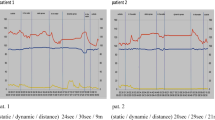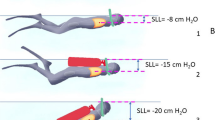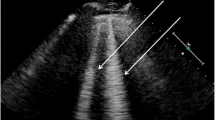Abstract
While swimming represents a popular recreational activity, the immersion of the human body into the water requires a complex physiologic adaption of the whole cardiopulmonary and circulatory system. While this sport is regarded as beneficial, especially in cardiovascular patients, current guidelines hypothesized a possible hazardous effect of swimming and especially diving in patients with univentricular hearts after Fontan palliation. Yet, actual data to underline or contradict these assumptions are lacking. Therefore, this study aimed to conduct a first feasibility study for the evaluation of these effects on Fontan physiology and elucidate the gap of evidence currently preventing patients after Fontan palliation from being restricted from swimming or diving on doctoral advice. Patients recruited from the Heart Center Leipzig, Department of pediatric cardiology, underwent spiroergometry treadmill testing followed by a spiroergometry swimming stress test in a counter current pool. Physiologic data were recorded. A short apnea diving test was performed. The current study found similar physiologic reactions comparing treadmill and swimming exercise stress testing. Heart rate response and oxygen uptake were comparable on land and in the water. This study presents the first-in-man data on swimming and diving in Fontan patients. In this small study cohort of three Fontan patients, there were no adverse events triggered by swimming and breath-hold diving seen. Basically, the physiologic response to exercise was comparable on land and in the water.









Similar content being viewed by others
References
Lazar JM, Khanna N, Chesler R, Salciccioli L (2013) Swimming and the heart. Int J Cardiol 168(1):19–26
Epstein M (1978) Renal effects of head-out water immersion in man; implications for understanding of volume homeostasis. Physiol Rev 58:529
Lehmann M, Samek L (1990) Recreational swimming in CHD patients and healthy control subjects in relation to left heart function. Clin Cardiol 13(8):547–554
Lotshaw AM, Thompson M, Sadowsky S, Hart MK, Millard MW (2007) Quality of life and physical performance in land- and water-based pulmonary rehabilitation. J Cardiopulm Rehabil Prev 27:247–251
Shah P, Pellicori P, Macnamara A, Urbinati A, Clark AL (2017) Is swimming safe in heart failure? A systematic review. Cardiol Rev 25(6):321–325
Asplund CA, Creswell LL (2016) Hypothesised mechanisms of swimming-related death: a systematic review. Br J Sports Med 50(22):1360–1366
Pelliccia A et al (2020) ESC Guidelines on sports cardiology and exercise in patients with cardiovascular disease. The Task Force on sports cardiology and exercise in patients with cardiovascular disease of the European Society of Cardiology (ESC). Eur Heart J. https://doi.org/10.1093/eurheartj/ehaa605
Aadland E, Solbraa AK, Resaland GK, Steene-Johannessen J, Edvardsen E, Hansen BH, Anderssen SA (2017) Reference values for and cross-validation of time to exhaustion on a modified Balke protocol in Norwegian men and women. Scand J Med Sci Sports 27(11):1248–1257
Fitz-Clarke JR (2018) Breath-hold diving. Compr Physiol 8(2):585–630
Arborelius M, Bllidin UI, Lilja B, Lundgren CE (1972) Hemodynamic changes in man during immersion with the head above water. Aerosp Med 43:592–598
Park KS, Chois JK, Park YS (1999) Cardiovascular regulation during water immersion. Appl Human Sci 18:233–241
Lin YC (1984) Circulatory functions during immersion and breathhold dives in humans. Unsersea Biomed Res 11:123–138
Campbell LB, Gooden BA, Horowitz JD (1969) Cardiovascular response to partial and total immersion in man. J Phyiol (Lond) 202:239–250
Lollgen SH, von Nieding G, Koppenhagen K, Kerstin F, Just H (1981) Hemodynamic response to graded water immersion. Klin Wochenschrift 59:623–628
Rahn H, Otis AB, Chadwick LE, Fenn WO (1946) The pressure volume diagram of the thorax and lung. Am J Physiol 146:161–178
Kurss DI, Lundgren CEG, Pasche AJ (1971) Effects of water temperature on vital capacity in headout immersion. In: Bachrach AJ, Matzgen MM (eds) Underwater physiology VII. Undersea Medical Society, Bethesda, MD, pp 297–301
Yamaguchi H, Tanaka H, Obara S, Tanabe S, Utsuyama N, Takahashi A, Nekahira J, Yamamoto Y, Jiang ZL, He J (1993) Changes in cardiac rhythm in man during underwater subermsion and swimming studied by ECG telemetry. Eur J Appl Physiol 66:43–48
Speck DF, Bruce DS (1978) Effects of varying thermal and apneic conditions on the human diving reflex. Undersea Biomed Res 5:9–14
Arunamata A, Tacy TA, Kache S, Mainwaring RD, Ma M, Maeda K, Punn R (2020) Recent outcomes of the extracardiac Fontan procedure in patients with hypoplastic left heart syndrome. Ann Pediatr Cardiol 13(3):186–193
Stellin G (2020) A Tribute to the pioneers of right heart bypass: an historical review. World J Pediatr Congenit Heart Surg 11(2):198–203
Bucholz EM, Sleeper LA, Goldberg CS, Pasquali SK, Anderson BR, Gaynor JW, Cnota JF, Newburger JW (2020) Socioeconomic Status and long-term outcomes in single ventricle heart disease. Pediatrics 146(4):e20201240
Scheffers LE, Berg LEV, Ismailova G, Dulfer K, Takkenberg JJ, Helbing WA (2020) Physical exercise training in patients with a Fontan circulation: a systematic review. Eur J Prev Cardiol. https://doi.org/10.1177/2047487320942869
Holbein CE, Veldtman GR, Moons P, Kovacs AH, Luyckx K, Apers S, Chidambarathanu S, Soufi A, Eriksen K, Jackson JL, Enomoto J, Fernandes SM, Johansson B, Alday L, Dellborg M, Berghammer M, Menahem S, Caruana M, Kutty S, Mackie AS, Thomet C, Budts W, White K, Sluman MA, Callus E, Cook SC, Khairy P, Cedars A (2019) Perceived health mediates effects of physical activity on quality of life in patients with a fontan circulation APPROACH-IS consortium and the International Society for Adult Congenital Heart Disease (ISACHD). Am J Cardiol 124(1):144–150
Disclosure
The authors have no financial relationships relevant to this article to disclose.
Funding
The current study was funded by the Kinderherzkammer Leipzig e.V.. The study was supported by CORTEX Biophysik GmbH.
Author information
Authors and Affiliations
Corresponding author
Ethics declarations
Conflict of interest
The authors declare to have no conflicts of interest.
Ethical approval
All procedures performed in studies involving human participants were in accordance with the ethical standards of the institutional and / or national research committee and with the 1964 Helsinki declaration and its later amendments or comparable ethical standards. The study received ethical approval by the ethics committee University of Leipzig and is listed under the reference 549/19-ek.
Additional information
Publisher's Note
Springer Nature remains neutral with regard to jurisdictional claims in published maps and institutional affiliations.
Rights and permissions
About this article
Cite this article
Paech, C., Gebauer, R.A., Weidenbach, M. et al. The Fontan and the Sea: First-in-Man Data on Swimming and Diving Physiology in Fontan Patients. Pediatr Cardiol 42, 1614–1624 (2021). https://doi.org/10.1007/s00246-021-02649-3
Received:
Accepted:
Published:
Issue Date:
DOI: https://doi.org/10.1007/s00246-021-02649-3




